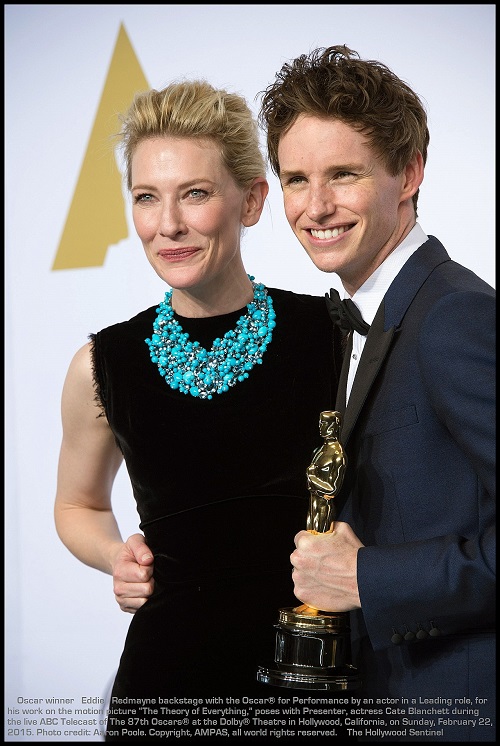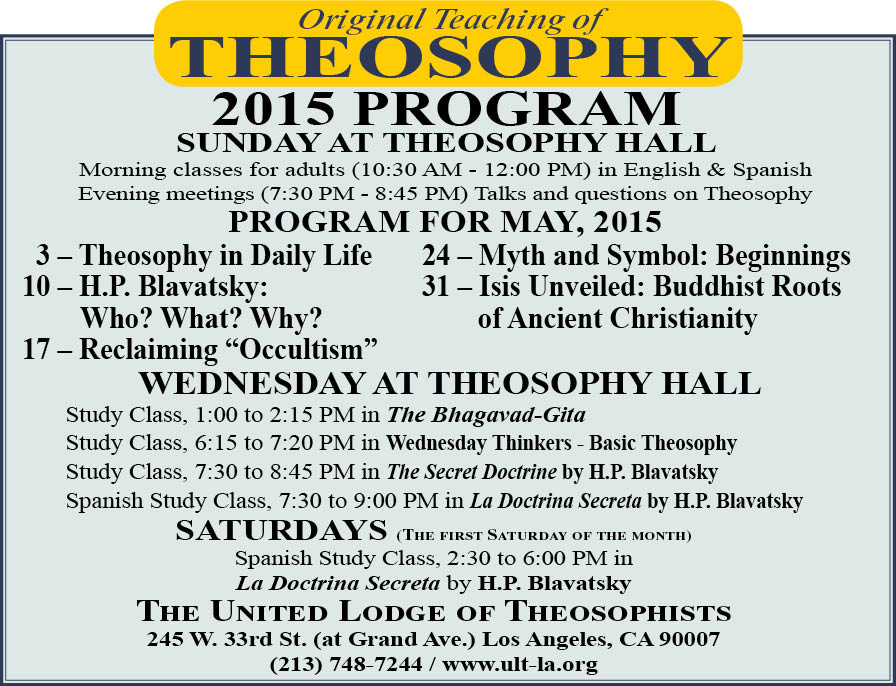
Best Actor: Eddie Redmayne - The Theory of Everything

The following is an exclusive interview backstage at The Oscars this year 2015 with Eddie Redmayne. Eddie Redmayne won for best Performance by an Actor in a leading role, for his work in the film The Theory of Everything.
Interview with Eddie Redmayne
Question: Congratulations so much for this win. We actually spoke a couple of months ago about your work with a ballet dancer to work on the degenerative parts of the disease and to sort of work them into a choreography. Could you tell them a little bit about that?

Eddie Redmayne: Absolutely. So when I was approaching the film, we knew we weren't going to be out of shoot chronologically. So we were going to have to jump into different stages in Stephen's life and within the same day. And so I didn't want for Stephen—the illness was of very little interest to him after he was diagnosed. He's someone that lives forward and lives passionately. And so, similarly, I didn't want the film to be about the physicality. So I wanted to have the physicality so embedded in me that we could play the human story, the love story. And so I went to ALS clinics in London for about four months with a choreographer, wonderful Alex Reynolds, and she helped to sort of train my muscles to sustain those positions for long periods of time.
(...) their support (The Hawking family) throughout has been amazing. Any excuse to go back to Cambridge, it's such a beautiful place. So, yeah, I will definitely go and show (the award to them). [words in parenthesis, the editor].
Question: (...) I wanted to ask you about the pressures of playing someone that is still alive because obviously there's a lot of biopics, and there obviously is a huge weight like for Alan Turing and "The Imitation Game." But with this, that person is going to watch that movie. How did you feel about it and how did that change your approach to it?
Eddie Redmayne: I don't know if it changed my approach, but what it did was there were various things of this job. I—in preparation, I met people living with ALS, they let me into their lives, they were incredibly kind to me. It was essential to me that I was authentic to what that experience is like. Then it's about the science, getting the science right, you know, and then of course the main thing about Stephen, Jane, Jonathan and the kids is being true to them and then also making an entertaining film. There were basically so many things that like terrified me about this film, but of course it galvanizes you, it makes you—when the stakes are that high, it does force you to work harder and so that's what I tried to do. And yeah, it's been amazing.

Best Music: Alexandre Desplat
The following is an interview with Alexandre Desplat backstage at the Oscars. Alexandre Desplat won the 2015 Oscar for Best Music, Original Score, for his music in the film "The Grand Budapest Hotel." Alexandre was also nominated for his music in the film "The Imitation Game."
Alexandre Desplat: Interview
Question: I know you've worked with Wes Anderson before. Can you talk a little bit about the give and take between the two of you, how much does he approve, how much does he disapprove, and how much freedom do you really get?
Alexandre Desplat: Well, it's all—it's all him. Actually, he should have won this award. Well, you know, Wes, as any great director, is very detailed. He likes to be precise, obsessively, but like not different from Morten Tyldum, (...) or Jacques Audiard. They are (...) great directors, and so they are very demanding; and they want everything to fit perfectly in. The thing about Wes's movie (...) and in his previous movies we have done together, "Mr. Fox" and "Moonrise Kingdom," music is really interwoven very strongly to the editing, to the rhythm of the film. I guess that's the most important thing in our relationship. And, also, when we sit together in my studio, very quickly (...)—we get excited about ideas, and I try to give a shape to that musically very quickly. And (...) it's like arborescence, you know, you find an idea that brings another one. And we really work on the same level and very, very closely.
Maureen O’Hara
2015 Honorary Awards recipient
Maureen O’Hara first captured the public’s eye in her breakout role as the dancing gypsy, Esmeralda, in The Hunchback of Notre Dame. She has held our attention ever since. Known for playing feisty heroines, O'Hara's famously flame-red hair lit up the screen like no other star from Hollywood’s golden age. In a career that has spanned over seventy-five years, she has starred in over sixty motion pictures including such critically acclaimed classics as Miracle on 34th Street, The Quiet Man, and How Green Was My Valley. She is widely recognized as Ireland's most renowned and celebrated actress.
Born Maureen FitzSimons on August 17, 1920 in Ranelagh, Ireland, O’Hara began acting at age five with her own shadow. She studied at the Ena Mary Burke School of Elocution and Drama and by age ten had joined the Rathmines Theatre Company working in amateur productions. She was soon hired by Radio Telefis Eireann (RTE) to perform classic plays over the radio reaching nearly every household in Ireland.
As a teenager, Maureen FitzSimons joined the famed Abbey Theatre and worked nights typing tags at a local laundry. She was offered a leading role with the Abbey Players at age seventeen but chose instead to take a motion picture screen test in London at the request of Elstree Studios. Her screen test caught the attention of Oscar-winning actor and producer Charles Laughton, who quickly signed her to a seven-year contract. Laughton launched his new protégé’s film career by casting her as his niece, Mary Yellan, in Alfred Hitchcock's Jamaica Inn (1939) and by changing her screen name to Maureen O’Hara.
Maureen O’Hara first arrived in Hollywood in 1939 to make her American film debut (opposite Laughton’s Quasimodo) in The Hunchback of Notre Dame. She was unable to return to Ireland with the outbreak of World War II and became part of Hollywood’s studio system when her contract was sold to RKO Pictures. In 1941, O'Hara achieved critical acclaim for her haunting portrayal of Angharad in the Welsh family saga How Green Was My Valley, which marked her first collaboration with legendary director John Ford. The film went on to win five Oscars including Best Picture and Best Director.
During the 1940s and 1950s, O'Hara was often cast in lavish Technicolor movies. Her fiery characters and striking features earned her the nickname "Queen of Technicolor." O’Hara is also the first female action star, having performed many of her own stunts and sword fighting sequences in swashbuckling pictures. The most notable include The Black Swan with Tyrone Power, Sinbad the Sailor with Douglas Fairbanks Jr., and At Sword’s Point with Cornel Wilde. In 1947, O'Hara appeared in the holiday classic Miracle on 34th Street, playing a single mother whose sensibilities are challenged by Santa Claus.
This period in O’Hara’s career is also highlighted by her frequent work with John Ford and John Wayne. Her screen chemistry with Wayne was dynamic and she served as “the Duke’s leading lady” in a series of Ford films including Rio Grande, The Wings of Eagles, and her personal favorite, The Quiet Man.
O'Hara turned to lighter roles in the 1960s appearing in family comedies such as The Parent Trap, Mr. Hobbs Takes a Vacation, McLintock!, and Spencer’s Mountain. In 1971, she reunited with John Wayne a final time in the western comedy Big Jake, before retiring to operate a Caribbean commuter airline with her husband, aviator Charles F. Blair. Upon Blair’s tragic death in a plane crash, O’Hara became the first woman in United States history to head a scheduled commercial airline. In 1991, following a 20-year hiatus, O'Hara returned to the silver screen to play John Candy's overbearing Irish mother in the bittersweet comedy Only the Lonely. She later starred in a string of television movies and published her bestselling memoir, Tis Herself, in 2004.
Hayao Miyazaki
2015 Honorary Awards recipient
Born in 1941 in Tokyo, Japan. After graduating from Gakushuin University in 1963 with a degree in Political Science and Economics, Hayao Miyazaki joined Toei Animation Company as an animator. He worked under the director Isao Takahata for scene planning and key animation for the production of THE LITTLE NORSE PRINCE VALIANT (1968). He then moved to the animation studio A Production with Takahata in 1971 where he worked on the original concept, screenplay, layout design and key animation for PANDA! GO PANDA! (1972). Miyazaki worked at various studios including Zuiyo Eizo with Takahata, Nippon Animation, and Telecom, and did scene planning and layout designs for the TV series HEIDI, A GIRL OF THE ALPS (1974) and FROM THE APENNINES TO THE ANDES (1976), and directed his first TV series CONAN, THE BOY IN FUTURE (1978). He debuted as a director of theatrical features with THE CASTLE OF CAGLIOSTRO (1979). In 1984, Miyazaki wrote and directed his feature NAUSICAÄ OF THE VALLEY OF THE WIND, based on his original graphic novel serialized in the monthly animation magazine “Animage”.
Miyazaki co-founded Studio Ghibli in 1985 with Takahata, and has directed nine feature films since, including CASTLE IN THE SKY (1986), MY NEIGHBOR TOTORO (1988), KIKI’S DELIVERY SERVICE (1989), PORCO ROSSO (1992) and PRINCESS MONONOKE (1997). SPIRITED AWAY (2001) broke every box office record in Japan, and garnered many awards, including the Golden Bear at the 2002 Berlin International Film Festival and the Oscar for Best Animated Feature Film at the 2003 U.S. Academy Awards. HOWL’S MOVING CASTLE (2004) received the Osella Award at the 2004 Venice International Film Festival. Miyazaki was awarded the Golden Lion for Lifetime Achievement at the 2005 Venice International Film Festival. He wrote and directed PONYO ON THE CLIFF BY THE SEA (2008). He contributed to the planning and wrote the screenplays for Hiromasa Yonebayashi’s ARRIETTY (2010) and Goro Miyazaki’s FROM UP ON POPPY HILL (2011). In 2012, Miyazaki was named a “Person of Cultural Merit” by The Government of Japan.
Miyazaki has published a number of books of essays, drawings and poems, including “Shuppatsuten 1979-1996 (Starting Point: 1979- 1996, 1996)”. He has designed several buildings, including the Ghibli Museum, Mitaka, which opened in 2001, for which he serves as Executive Director. His new film, THE WIND RISES, opened in July 2013 in Japan.
TV Series
CONAN, THE BOY IN FUTURE (Mirai Shonen Konan), 1978
Feature Films
THE CASTLE OF CAGLIOSTRO (Rupan Sansei Kariosutoro no Shiro), 1979
NAUSICAÄ OF THE VALLEY OF THE WIND (Kaze no Tani no Nausicaä), 1984
CASTLE IN THE SKY (Tenku no Shiro Laputa), 1986
MY NEIGHBOR TOTORO (Tonari no Totoro), 1988
KIKI’S DELIVERY SERVICE (Majo no Takkyubin), 1989
PORCO ROSSO (Kurenai no Buta), 1992
PRINCESS MONONOKE (Mononoke Hime), 1997
SPIRITED AWAY (Sen to Chihiro no Kamikakushi), 2001
HOWL’S MOVING CASTLE (Hauru no Ugoku Shiro), 2004
PONYO ON THE CLIFF BY THE SEA (Gake no Ue no Ponyo), 2008
THE WIND RISES (Kaze Tachinu), 2013
This page is © 2015, The Hollywood Sentinel, and The 87th Academy Awards®. All content Copyright 2015 Academy of Motion Picture Arts and Sciences, © The Oscars® 2015, all world rights reserved.